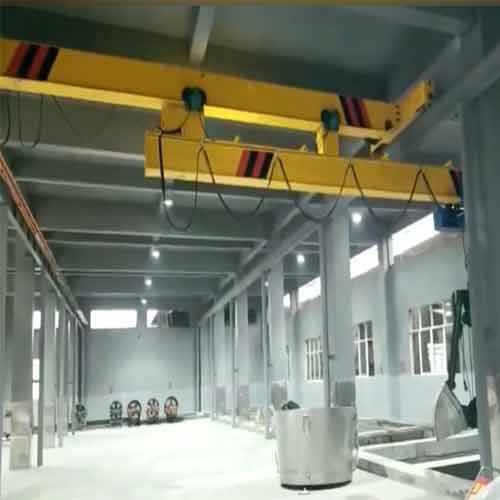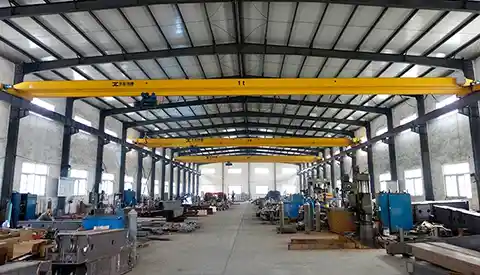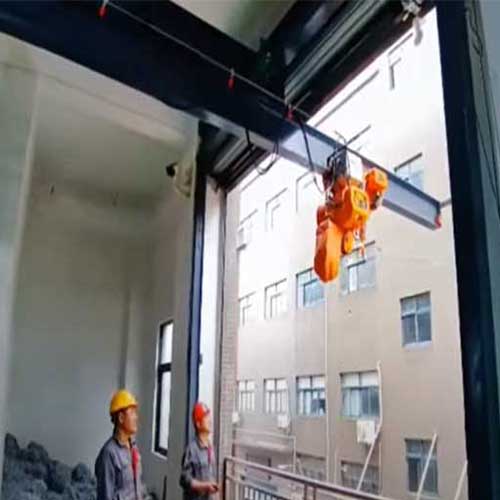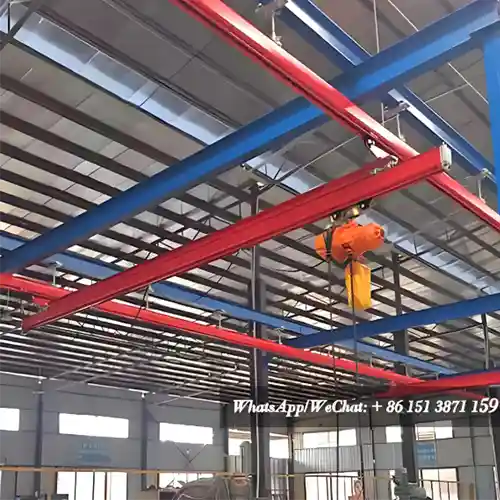Top Running Telescoping Crane for Sale, Maximizing Vertical Space
Telescoping top running bridge crane for sale. Check how the top running telescoping bridge cranes to maximize vertical space in industrial settings.
Category: Telescoping Overhead Crane
Your Trusted Telescoping Bridge Crane Manufacturer & Supplier
Maximizing Vertical Space: The Advantages of Top Running Telescoping Cranes
In the fast-paced world of industrial manufacturing and material handling, efficiency is the name of the game. The ability to optimize space, streamline operations, and ensure workplace safety is paramount. This is where top running telescoping cranes come into play, offering a solution that not only meets these requirements but exceeds expectations.
In this article, we will explore the remarkable advantages of top running telescoping bridge cranes and how they are revolutionizing material handling in various industries. These cranes are more than just machines; they are the embodiment of precision, versatility, and vertical space optimization.
Top Running Telescoping Cranes: An Overview
Top running telescoping bridge cranes, also known as top running telescopic cranes, are a specialized type of overhead crane designed to maximize both horizontal and vertical space in industrial settings. These cranes are known for their unique design features and their primary function of optimizing material handling operations. Let's take a closer look at what sets them apart and how they work:
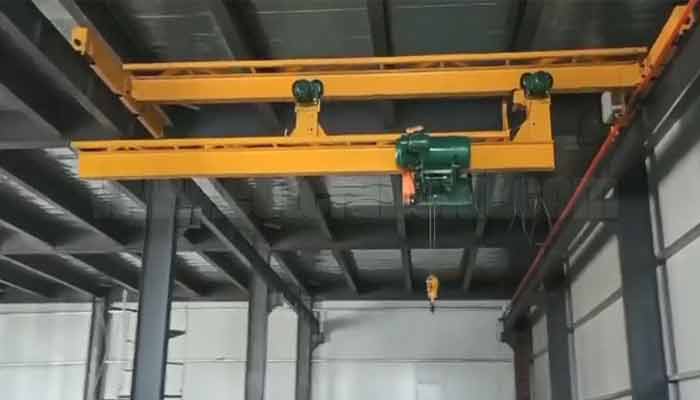
Telescoping bridge top running bridge crane
Design Features:
- Telescoping Girder: The defining feature of top running telescoping cranes is their telescoping girder. This girder can extend and retract, providing exceptional reach and flexibility in load positioning. It allows these cranes to adapt to various material handling needs.
- Top Running Configuration: These cranes are typically mounted on the top of a facility's structure, operating along overhead runways. The top running configuration ensures that the crane has maximum coverage of the workspace without consuming valuable floor space.
- Hoist and Trolley System: Top running telescoping cranes are equipped with a hoist and trolley system that moves along the girder. This system is designed for precise load handling and positioning.
Primary Function in Material Handling:
The primary function of top running telescoping cranes is to provide a versatile and efficient solution for material handling. They excel in the following aspects:
- Vertical Space Optimization: These cranes are designed to make the most of vertical space within industrial settings. The telescoping girder extends upward, allowing the crane to reach greater heights. This feature is particularly advantageous in facilities where vertical space is limited.
- Precise Load Positioning: The telescoping mechanism of these cranes enables precise load positioning. Whether it's lifting heavy machinery components or delicate materials, top running telescoping cranes offer exceptional accuracy.
- Adaptability: These cranes are highly adaptable to various material handling tasks. Their flexibility in extending and retracting the girder makes them suitable for a wide range of applications, from manufacturing and assembly to warehousing and more.
In essence, top running telescoping cranes are engineered to overcome the challenges posed by limited vertical space, making them a valuable asset in industrial settings where efficient material handling is a top priority. Their unique design features and primary function set them apart as a reliable and versatile solution for businesses looking to optimize their operations.
The Vertical Space Challenge
In the realm of industrial facilities, limited vertical space is a pervasive challenge that can significantly impact productivity and safety. Let's dive into this challenge and understand the implications of inefficient use of space:
The Challenge of Limited Vertical Space:
Industrial settings often find themselves constrained by the vertical dimension. The reasons for limited vertical space can vary, but some common factors include:
- Facility Size: Smaller industrial facilities inherently have less vertical space to work with. As businesses grow and require more equipment, machinery, and storage, the available vertical space becomes a valuable commodity.
- Ceiling Height: The height of the facility's ceiling plays a critical role in determining vertical space. Low ceilings can limit the types of equipment and material handling solutions that can be deployed.
- Structural Constraints: Structural elements within the facility, such as support beams and columns, can further reduce usable vertical space. These structural components may be necessary for the facility's integrity but can impede material handling operations.
- Occupancy Regulations: Compliance with safety and occupancy regulations can also limit the use of vertical space. Certain areas must remain clear for safety reasons, reducing the available space for material handling.
Impact on Productivity:
The inefficient use of vertical space can have a cascading effect on productivity within industrial facilities:
- Congestion: When vertical space is not maximized, congestion can occur at ground level. This congestion can slow down the movement of materials and reduce overall productivity.
- Inefficient Layouts: Inadequate vertical space can lead to inefficient layout designs, where equipment and storage solutions are scattered across the floor. This makes it challenging to streamline material handling processes.
- Reduced Storage Capacity: Limited vertical space directly impacts storage capacity. Businesses may not be able to store as many materials or products, requiring them to find off-site storage solutions or implement just-in-time inventory systems.
Impact on Safety:
Safety is a paramount concern in industrial settings, and inefficient use of vertical space can compromise safety in several ways:
- Obstructions: Insufficient vertical space can lead to obstructions on the floor, creating potential hazards for workers and equipment.
- Limited Maneuverability: With reduced vertical space, machinery and equipment may have limited maneuverability. This can make it challenging to transport materials safely and efficiently.
- Overhead Hazards: Low ceilings or overhead obstructions can pose dangers when lifting or positioning heavy loads. These hazards can result in accidents or damage to equipment.
- Ergonomic Strain: Inefficient layouts due to limited vertical space can force workers to perform tasks in less-than-ideal ergonomic conditions, leading to long-term health issues.
In conclusion, the challenge of limited vertical space in industrial facilities is a critical consideration. Inefficient use of this space can hinder productivity, create safety hazards, and impact the overall efficiency of material handling operations. It is within this context that top running telescoping cranes, with their unique ability to maximize vertical space, prove to be a game-changing solution for industries striving for safer, more efficient, and productive work environments.
Unique Benefits of Top Running Telescoping Cranes
When it comes to addressing the challenge of limited vertical space in industrial facilities, top running telescoping cranes stand out as an innovative and practical solution. These cranes offer a range of unique benefits that make them an invaluable asset in optimizing material handling operations:
Greater Reach for Vertical Space Optimization:
Top running telescoping cranes are designed with a telescoping girder that extends and retracts, providing them with the ability to reach greater heights than traditional overhead cranes. This feature enables several advantages:
- Maximized Vertical Space: These cranes are ideal for facilities with limited vertical space. By reaching greater heights, they optimize the utilization of vertical space, allowing businesses to store materials or perform lifting and positioning tasks efficiently.
- High-Lift Capability: The telescoping mechanism allows these cranes to hoist heavy loads to elevated positions, making them well-suited for applications where materials need to be stored or positioned at considerable heights.
Precise Load Positioning:
Top running telescoping cranes are known for their precision in load handling and positioning. Their ability to extend and retract the girder with accuracy brings several benefits:
- Pinpoint Load Placement: Whether it's positioning machinery components in manufacturing or placing materials on elevated storage racks, these cranes offer pinpoint accuracy. This ensures that items are precisely where they need to be, reducing the risk of damage and improving overall efficiency.
- Reduced Material Handling Errors: The precise load positioning minimizes material handling errors, leading to fewer accidents and reduced rework. This contributes to both safety and cost-effectiveness.
- Versatility: The ability to accurately position loads, whether light or heavy, makes top running telescoping cranes highly versatile in a range of material handling applications.
Adaptability and Flexibility:
One of the key advantages of these cranes is their adaptability to different material handling needs:
- Wide Range of Applications: Top running telescoping cranes can be used in various industries and settings, including manufacturing, assembly, warehousing, and more. They adapt to diverse operational requirements.
- Flexible Load Capacity: The cranes can be customized to handle different load capacities, making them suitable for both light and heavy material handling tasks.
- Changing Work Environments: The telescoping girder's adaptability allows these cranes to excel in evolving work environments. They can be reconfigured or adjusted to accommodate changes in the layout or nature of material handling operations.
In essence, top running telescoping cranes provide a solution that not only addresses the vertical space challenge but also enhances overall material handling efficiency. Their ability to reach greater heights, offer precise load positioning, and adapt to various applications positions them as a strategic investment for industries looking to maximize vertical space, improve productivity, and ensure the safe and efficient handling of materials.
Application
To fully grasp the impact of top running telescoping cranes on material handling, let's delve into real-world examples and industries where these cranes excel. These versatile machines play a pivotal role in various applications, providing solutions that go beyond addressing the challenge of limited vertical space. Here are some noteworthy scenarios:
Automotive Assembly:
In the fast-paced world of automotive manufacturing, precision and efficiency are paramount. Top running telescoping cranes are instrumental in this industry, particularly in the following applications:
- Assembly Line Handling: These cranes transport car parts and components to assembly lines with remarkable precision, enabling the smooth and accurate positioning and assembly of complex automotive systems.
- Paint Booths: Automotive paint booths require the precise positioning of vehicle bodies or parts for painting. Top running telescoping cranes facilitate this critical step, ensuring that every inch of the vehicle receives an even coat of paint.
Aerospace Manufacturing:
Aerospace manufacturing demands exacting standards and meticulous handling of large and sensitive components. Top running telescoping cranes find their place in this industry, serving two key functions:
- Aircraft Manufacturing: These cranes are essential for the careful handling of massive aircraft components, such as wings and fuselage sections. Their precision ensures that no element is damaged during assembly.
- Aerospace Maintenance: In the maintenance and repair of aircraft, top running telescoping cranes assist in hoisting and positioning the aircraft for inspections and repairs, contributing to the safety and efficiency of the process.
Heavy Machinery Manufacturing:
Manufacturers of heavy machinery components benefit greatly from the capabilities of these cranes:
- Machine Shop Operations: Machine shops use top running telescoping cranes for moving heavy machinery components during the machining and manufacturing process. The cranes' precision ensures that these components are accurately positioned for machining and assembly.
Warehouse and Storage Facilities:
Optimizing storage space and efficient material handling are key in warehousing and storage operations:
- Vertical Storage: In warehouses, these cranes are used for efficient vertical storage. They enable the stacking of goods and materials in a space-effective manner, making the most of the available height.
Multi-Purpose Material Handling:
Beyond specific industries, top running telescoping cranes find application in a multitude of scenarios:
- Versatile Material Handling: Their adaptability and flexibility make them a valuable asset for general material handling in diverse settings. Whether it's moving equipment, stacking goods, or facilitating assembly processes, these cranes rise to the occasion.
- Variable Load Capacities: Top running telescoping cranes can be configured to handle a wide range of load capacities, ensuring they are suitable for light and heavy-duty applications.
The applications of top running telescoping cranes are diverse and adaptable, underscoring their significance in industries where efficient material handling is a priority. They not only address the challenge of limited vertical space but also enhance precision, safety, and overall operational efficiency in various industrial settings.
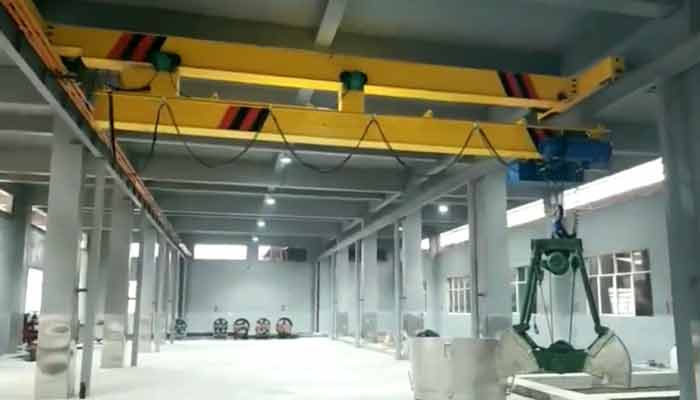
Telescoping bridge top running overhead crane used for low headroom workshop to improve vertical space
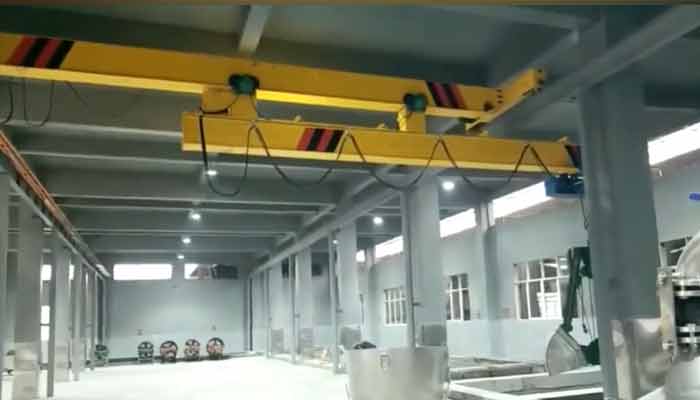
Telescoping bridge top running overhead crane for low headroom facility
Maximizing Efficiency and Productivity
Efficiency and productivity are the cornerstones of success in industrial operations. In this section, we'll explore how top running telescoping cranes play a pivotal role in maximizing these key factors and how they contribute to streamlined operations and reduced downtime:
Streamlined Material Handling:
Top running telescoping cranes are engineered for precise and efficient material handling. This translates into several tangible benefits for businesses:
- Quick Load Positioning: The telescoping feature of these cranes allows for rapid load positioning, reducing the time it takes to complete tasks. This is especially valuable in time-sensitive operations, such as assembly lines and manufacturing processes.
- Reduced Material Handling Steps: Their precision ensures that materials are placed exactly where they need to be, eliminating the need for extra handling steps. This minimizes the risk of errors, damage, and rework.
Improved Safety and Reduced Downtime:
Safety is a paramount concern in industrial settings, and top running telescoping cranes are designed with safety in mind:
- Overload Protection: These cranes are equipped with advanced safety features, including overload protection systems. This not only safeguards the equipment but also reduces the risk of accidents and downtime due to overloading.
- Emergency Stop Mechanisms: In case of unforeseen circumstances, the cranes are equipped with emergency stop mechanisms. This quick response capability ensures that operations can be halted safely when necessary.
- Reduction in Accidents: Precise load positioning minimizes the risk of accidents, ensuring that materials are placed accurately and securely. This, in turn, reduces workplace injuries and damage to equipment.
Increased Productivity and Cost Savings:
The efficiency and safety enhancements brought about by top running telescoping cranes lead to tangible productivity gains and cost savings:
- Shortened Production Cycles: Quick load positioning and reduced handling steps shorten production cycles. This means that products are manufactured or assembled at a faster pace, improving time-to-market and overall productivity.
- Reduced Rework Costs: The precision of these cranes significantly reduces the need for rework due to material mishandling or damage. This results in cost savings and ensures that resources are used efficiently.
- Long-Term Efficiency: The enhanced efficiency brought about by top running telescoping cranes contributes to long-term cost savings and improved competitiveness in the market.
In conclusion, top running telescoping cranes are instrumental in maximizing efficiency and productivity in industrial settings. Their ability to streamline material handling, improve safety, and reduce downtime directly translates into operational enhancements. With shortened production cycles, reduced rework costs, and long-term efficiency, these cranes are a strategic investment for businesses looking to stay competitive and efficient in today's fast-paced industrial landscape.
Safety Considerations
Safety is a paramount concern in industrial settings, and top running telescoping cranes are designed with advanced safety features and protocols to ensure a secure working environment. In this section, we'll delve into the safety aspects associated with these cranes and how they contribute to the well-being of workers and the protection of assets:
Overload Protection:
Top running telescoping cranes are equipped with overload protection systems. These systems are designed to monitor the load being lifted and alert operators when it approaches or exceeds the crane's rated capacity. The significance of overload protection includes:
- Preventing Accidents: Overload protection systems help prevent accidents and equipment damage by alerting operators when the load is too heavy. This reduces the risk of accidents due to overloading.
- Asset Protection: Overloading can cause long-term damage to the crane and other equipment. By avoiding overloads, businesses protect their valuable assets, extending the lifespan of the crane and associated machinery.
Emergency Stop Mechanisms:
In the event of unforeseen circumstances or emergencies, top running telescoping cranes are equipped with emergency stop mechanisms. These mechanisms provide a means to rapidly halt crane operations, ensuring:
- Immediate Response: When safety is compromised, the ability to stop crane operations quickly is crucial. Emergency stop mechanisms enable an immediate response to mitigate risks.
- Injury Prevention: The rapid halting of crane movement can prevent accidents and injuries. It also safeguards the materials being handled, reducing the risk of damage.
Precision Load Positioning:
The precision offered by top running telescoping cranes is itself a safety feature. Accurate load positioning reduces the likelihood of accidents and damage:
- Minimized Material Handling Errors: Accurate load positioning minimizes material handling errors. This, in turn, reduces the risk of accidents due to misplacement or mishandling of materials.
- Worker Safety: The precise placement of loads means that workers are less likely to be in the path of moving materials, contributing to a safer work environment.
Safe Working Environment:
The safety features of top running telescoping cranes, in combination with their precision and adaptability, help establish a safer working environment in industrial facilities:
- Reduced Accidents: By minimizing the risk of accidents, these cranes create a work environment with fewer safety incidents. This has a positive impact on worker morale and well-being.
- Compliance: The use of safe and compliant equipment is essential in meeting safety regulations and standards. Top running telescoping cranes are designed with these regulations in mind, ensuring that facilities remain compliant.
In conclusion, top running telescoping cranes are not only about material handling efficiency; they also prioritize the safety of workers and the protection of assets. Overload protection, emergency stop mechanisms, precise load positioning, and their general design features all contribute to a safer working environment in industrial facilities. By investing in these cranes, businesses enhance safety, reduce accidents, and ensure that operations adhere to the highest safety standards.
Customization Options
One of the remarkable aspects of top running telescoping cranes is their adaptability to specific material handling needs. In this section, we'll explore the customization options available, which allow businesses to tailor these cranes to their exact requirements and introduce additional features and accessories for enhanced functionality:
Load Capacity Customization:
Businesses can customize the load capacity of top running telescoping cranes to match the weight of the materials they handle. This adaptability is valuable for accommodating a wide range of loads, from lighter materials to heavy machinery components. Customized load capacity ensures that the crane is neither over- nor under-equipped for the task at hand.
Hoist and Trolley Systems:
The hoist and trolley systems on top running telescoping cranes can be customized to provide different levels of precision and control. For example:
- Variable Speed Controls: Businesses can opt for variable speed controls, allowing operators to adjust the speed at which loads are lifted and moved. This level of control is crucial in situations where precise positioning is required.
- Advanced Load Sensing: Some cranes can be equipped with load sensing technology, which provides real-time feedback on load weight and balance. This information aids operators in making accurate and safe load handling decisions.
Load Handling Accessories:
Various load handling accessories can be integrated with top running telescoping cranes to enhance their functionality. These accessories include:
- Specialized Hooks: Different types of hooks can be added to the hoist for handling specific loads. For example, there are hooks designed for lifting rolls, beams, and cylindrical objects.
- Lifting Magnets: Lifting magnets can be attached to the hoist for the efficient handling of ferrous materials such as steel sheets and components.
- Vacuum Lifters: Vacuum lifters are useful for lifting and moving non-porous materials like glass, wood, or plastic sheets.
Smart Crane Technologies:
The integration of smart technologies and automation features is becoming increasingly common in top running telescoping cranes. These technologies include:
- Remote Monitoring: With remote monitoring systems, operators can track the crane's performance, receive maintenance alerts, and access diagnostic information from a distance.
- Load Sensing and Feedback: Advanced sensors can provide real-time load sensing and feedback, allowing for more precise load positioning and enhanced safety.
- Safety Systems: Modern cranes often come with comprehensive safety systems that include collision avoidance, anti-sway, and emergency stop capabilities.
Radio Remote Control:
Radio remote control systems can be added to top running telescoping cranes, enhancing safety and precision. These systems allow operators to control the crane remotely, providing an unobstructed view of the load and the work area. This feature is particularly beneficial in applications where visibility is limited.
Customization options provide businesses with the flexibility to adapt top running telescoping cranes to their unique material handling needs. By selecting the right load capacity, hoist and trolley systems, load handling accessories, and smart crane technologies, companies can optimize their operations, improve efficiency, and ensure the safety of their workforce. The ability to integrate these features ensures that these cranes remain a versatile and tailored solution for a variety of industries and applications.
Examples of Applications
Real-world success stories provide a concrete understanding of how top running telescoping cranes can transform material handling operations. In this section, we'll explore case studies of businesses that have leveraged these cranes to achieve measurable improvements in their material handling processes and overall operations:
Automotive Manufacturing Plant
Challenge: Enhancing Assembly Line Efficiency
An automotive manufacturing plant faced the challenge of optimizing its assembly line efficiency. With the need for precise positioning of car components and the high demand for quick assembly, the plant required a material handling solution that could meet these requirements.
Solution: Top Running Telescoping Cranes
The plant implemented top running telescoping cranes in their assembly area. These cranes provided the necessary precision and versatility for transporting car parts to the assembly lines. The telescoping feature enabled the cranes to reach greater heights, making it easier to position components accurately.
Results:
- Reduced Assembly Time: The use of top running telescoping cranes reduced assembly time, contributing to an increase in the overall production rate.
- Improved Precision: The cranes' precise load positioning minimized errors in assembly, resulting in higher product quality and reduced rework.
Aerospace Manufacturing Facility
Challenge: Handling Large Aircraft Components
An aerospace manufacturing facility faced the challenge of safely and efficiently handling large aircraft components, including wings and fuselage sections. The facility needed a solution that could lift these heavy and delicate parts while ensuring the safety of the workers and the integrity of the components.
Solution: Top Running Telescoping Cranes
Top running telescoping cranes were introduced into the facility to address this challenge. These cranes offered the necessary load capacity and precision to hoist and position the large aircraft components. Their safety features, including overload protection, played a crucial role in ensuring the well-being of the workforce.
Results:
- Safe Handling: The cranes' safety features, combined with their precision, ensured the safe handling of large aircraft components without incidents or damage.
- Efficient Workflow: The cranes contributed to a more efficient workflow, allowing the facility to meet tight manufacturing deadlines.
Warehouse Optimization
Challenge: Vertical Storage and Maximizing Warehouse Space
A large warehouse facility faced a challenge in optimizing its storage space while efficiently stacking goods vertically. They needed a material handling solution that could make the most of their vertical space and enhance the overall efficiency of their warehouse operations.
Solution: Top Running Telescoping Cranes
Top running telescoping cranes were introduced to facilitate vertical storage within the warehouse. The cranes allowed the efficient stacking of goods and materials, maximizing the use of available vertical space.
Results:
- Increased Storage Capacity: The implementation of top running telescoping cranes led to a significant increase in storage capacity, allowing the facility to store more goods without expanding their footprint.
- Efficient Material Handling: The cranes streamlined material handling within the warehouse, reducing the time and effort required for stacking and retrieving goods.
These case studies underscore the versatility and impact of top running telescoping cranes in diverse industrial settings. Whether it's improving assembly line efficiency in automotive manufacturing, enhancing safety in aerospace facilities, or optimizing vertical storage in warehouses, these cranes have proven to be a valuable asset, contributing to increased productivity, safety, and overall operational efficiency.
Conclusion
In conclusion, top running telescoping cranes emerge as a pivotal solution for businesses seeking to maximize vertical space in their industrial operations. As we reflect on the key takeaways from this exploration, it becomes evident that these cranes are more than just material handling equipment; they are catalysts for transformation in efficiency, productivity, and safety. Let's recap the advantages of top running telescoping cranes and their significant role in elevating industrial operations:
- Precision and Versatility:Top running telescoping cranes offer precision load positioning, making them indispensable in applications that demand accuracy. Their telescoping feature allows them to reach greater heights, enhancing their versatility.
- Efficiency and Productivity:These cranes streamline material handling operations, reducing downtime, and shortening production cycles. The result is increased efficiency and productivity, leading to improved time-to-market and cost savings.
- Safety First:Safety is a paramount consideration, and these cranes are equipped with advanced safety features, including overload protection and emergency stop mechanisms. Their precise load positioning also minimizes the risk of accidents and damage.
- Customization Options:Top running telescoping cranes can be customized to fit specific material handling needs. Load capacity, hoist and trolley systems, load handling accessories, and smart crane technologies can all be tailored to suit the requirements of various industries.
Top running telescoping cranes are not just lifting equipment; they are strategic assets that empower businesses to overcome the vertical space challenge and achieve new heights in material handling. As industries continue to evolve, these cranes stand as reliable partners in the journey towards improved efficiency, productivity, and safety.
For those considering the adoption of top running telescoping cranes, the choice is more than a mere investment; it's a commitment to enhancing the way they do business. With the right crane, the sky is the limit, and the path to efficient, safe, and productive material handling is clearer than ever.
Related Products

Latest project
150 Ton Overhead Crane Installation Feedback – Paraguay Case
QDX 150 ton overhead crane in action in Paraguay. Installation photos, video, and client feedback show performance, safety, and heavy-lifting efficiency.
Free consultation to Confirm Parameters & Specifications and Get
Latest Crane Price & Crane Rate.
- Types of overhead cranes : _______?
- Optional: Overhead travelling crane, goliath gantry crane,Slewing jib crane, Single girder or double girder crane,small portable crane or kbk crane, etc.
- Capacity of overhead crane: _______?
- Optional: 0.25ton, 0.5 ton, 1 ton, 2 ton, 3ton, 5 ton, 10 ton,15ton, 20ton, 25 ton, 30ton,35ton, up to 550ton, etc.
- Crane span & lifting height : _______?
- Crane travelling length : _____?
- Control of overhead crane:_______?
- Optional: pendant/ remote/cabin control
- Voltage supply of overhead crane:_____?
- Eg,: 380V50/60HZ,3Phase or others,etc.
- Application/usage of crane:_______?
- Eg,: Steel mill, ,injection mold, cement,stone, concrete,granite, general manufacturing, etc.
Just leave a message via the contact form and our hoist and crane engineer will contact you with in 24working hours.
Get In Touch
